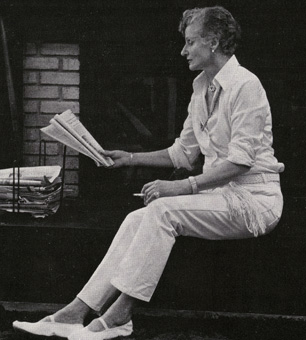View current page
...more recent posts
"Your Haploid Heart"
Fascinating article in Bookforum about CIA employee Alice Sheldon, who wrote science fiction under the name James Tiptree, Jr. The essay, discussing a recent bio by Julie Phillips, connects the themes of Tiptree's fiction to Sheldon's early life as the daughter of a writer/explorer traveling in Africa and Asia. I've only read one Tiptree story and didn't like it much but the story of her double life is intriguing, particularly the way political themes that could never been expressed in her "day job" got worked out in her fiction. It would be interesting to compare Tiptree's work to that of Paul Linebarger, another DC spook-type who wrote SF (as Cordwainer Smith). Sheldon was a Star Trek fan and I like this passage from the review:
"It was partly from colonial adventure stories like [Sheldon's mother's] that science fiction was born," Phillips observes. "The first time Alice saw Star Trek, she recognized it at once as a story about her childhood." This observation, like so many in this superb biography, strikes deep. It illuminates one of the darker corners of science fiction—its political unconscious, as it were. The writer's bible for Star Trek couldn't be clearer about the colonial echo: "Horatio Hornblower in space." The multicultural crew may look like it's been sent by the United Nations, but its gunship could wipe out a planet.But what about the Prime Directive? One thing I didn't know about Sheldon's life was how it ended. She feared aging and caring for a husband twelve years her senior, so they had a "suicide pact" in 1987 that the review suggests might have been a murder/suicide (Sheldon shot him and then herself). But her fiction seems every bit as renegade and "difficult" as that juicy story--I'm now eager to read more of it.
The early story "Your Haploid Heart" combines the love-death theme with another one of Tiptree's obsessions: the willingness of rational beings to exterminate "inferior" races in the name of progress. Representatives of the Galactic Federation have come to see if aliens they contacted generations ago qualify for admission to the Federation. Only "human" races do. It's the same question that preoccupied nineteenth-century colonialists: Are the natives human? The Federation's definition of human is sexual; if a race can interbreed with humans, it is human. The Esthaans are so eager to be accepted that ever since first contact with the Federation they've hidden a dirty secret—the inferior Flenni race that dwells on their planet. In truth, the Esthaans reproduce like mosses: They bud asexually to produce sexually active offspring, the Flenni, who are in turn the parents of the Esthaans (and who are, in fact, sexually compatible with humans). This biological fact is so inconvenient and repulsive to Esthaan ambitions that it has been repressed, and the Esthaans are on the verge of exterminating the Flenni, even though the consequences would be suicidal. Once again, the armature of this story is standard-issue SF—a single scientific fact, in this case the diploid-haploid reproductive cycle, is extrapolated, and its consequences drive the plot. But the depiction of psychosexual madness is an exceptional departure from the genre's norms. And a further barb: This lunacy was brought by the Federation with its offer, Be like us.Below, detail of a portrait of Alice Sheldon by Patti Perret, from The Faces of Science Fiction, 1984:

